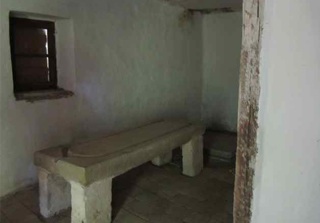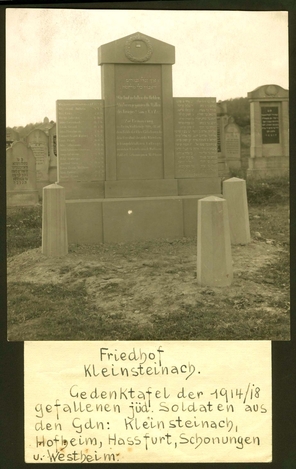the jewish Cemetery of kleinsteinach
On the history of the cemetery.
The Jewish cemetery in Kleinsteinach was already in existence by the 15th century, around 1453. It is the largest and oldest cemetery in the district of Hassberge and the second largest in Lower Franconia. The grounds has a total area of 122.24 square acres. It consists of an old and a new part. There are approximately 710 gravestones but actually there are over 1000 graves. The desecration of Jewish cemeteries started, as early as 1894. It continued during the 1920s and increased during the Nazi regime. On November 10, 1938 Jews were sent to the Kleinsteinach cemetery and were forced to destroy the graves of their own congregation. Also, the fact that some dead were buried without headstones makes it difficult to get an exact number as to how many are buried here.
The oldest gravestone is dated 1596. The first death was said to be a renowned Torah scholar. According to the records of the Chevra Kadisha (Holy Society) the Jews of several neighboring communities were buried here. Many rabbis and scholars are buried in the cemetery. The grave of Rabbi Shmuel Halevi from Meseritz, Poland who was the first rabbi in Bamberg is buried in Kleinsteinach. In 1772 the first burial records were kept. The gravestones are mainly inscribed in Hebrew but many have german inscriptions on the back of the headstones. The last burial was that of Daniel Mahler on January 18, 1942. The Kleinsteinach cemetery is now closed and is now under the National Association of the Jewish Communities of Bavaria. This organization raised money in the 1960's to restore and maintain the cemetery. The cemetery is located about 1.5 km southeast of Kleinsteinach near the sports field.
-

Tahara House
The Tahara House is located in the lower old part of the cemetery. The Tahara House has the original stone ritual purification table where the dead were washed before burial. After the body has been cleaned and then ritually washed, the person who died is dressed in linen garments and placed in the aron (the casket) and the aron is closed. The word aron, the Hebrew word for ark is also the word for casket in Hebrew, implying the preciousness of what it is the ark holds. Those who have performed the ritual washing (hevra kadisha) ask for forgiveness for any mistakes that might have been made during the tahara. Then, the priestly blessing is recited and the mitzvah has been completed.
-

World War 1 Memorial
A memorial monument for the fallen Jewish Soldiers of World War I from the communities of Kleinsteinach, Hofheim, Hassfurth, Schonungen and Westhem was erected in 1925. In honor of these fallen heroes the monument was unveiled in the Kleinsteinach cemetery. District Rabbi Dr. Ksinski from Burgpreppach gave the dedication speech. The inscription reads, "How are the mighty" Kleinsteinach citizen Max Neuman born 04/12/1894 lost his life on 02/23/1916. Other men from Kleinsteinach that fought in WW1 were Adolf Guttman born 07/30/1878, Moritz Neumann born 02/21/1889, Moritz Neumann born 01/31/1892, Sacki Gustav born 01/27/1888 and Sacki Moses born 01/15/1893. The Inscription on the war memorial says "How are the mighty, gone like the lost weapons of war. In memory of the world wars in 1914-1918 on the field of honor of the fallen soldiers in the cemetery area of the small Jewish communities connectting Kleinsteinach, Hofheim, Hassfurt, Schonungen and Westheim"
